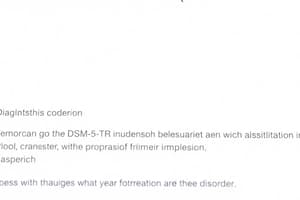Podcast
Questions and Answers
What distinguishes Autism Spectrum Disorder from Social (Pragmatic) Communication Disorder?
What distinguishes Autism Spectrum Disorder from Social (Pragmatic) Communication Disorder?
Which statement accurately contrasts Specific Learning Disorder and Attention Deficit Hyperactivity Disorder?
Which statement accurately contrasts Specific Learning Disorder and Attention Deficit Hyperactivity Disorder?
How do Pica and Rumination Disorder differ?
How do Pica and Rumination Disorder differ?
What sets Language Disorder apart from Childhood-Onset Fluency Disorder?
What sets Language Disorder apart from Childhood-Onset Fluency Disorder?
Signup and view all the answers
What difference exists between Tourette’s Disorder and Persistent Motor/Vocal Tic Disorder?
What difference exists between Tourette’s Disorder and Persistent Motor/Vocal Tic Disorder?
Signup and view all the answers
Which statement differentiates Encopresis from Enuresis?
Which statement differentiates Encopresis from Enuresis?
Signup and view all the answers
What characteristic differentiates Separation Anxiety Disorder from Generalized Anxiety Disorder?
What characteristic differentiates Separation Anxiety Disorder from Generalized Anxiety Disorder?
Signup and view all the answers
How does Selective Mutism differ from Social Anxiety Disorder?
How does Selective Mutism differ from Social Anxiety Disorder?
Signup and view all the answers
What distinguishes Reactive Attachment Disorder from Disinhibited Social Engagement Disorder?
What distinguishes Reactive Attachment Disorder from Disinhibited Social Engagement Disorder?
Signup and view all the answers
What key factor differentiates Oppositional Defiant Disorder from Conduct Disorder?
What key factor differentiates Oppositional Defiant Disorder from Conduct Disorder?
Signup and view all the answers
Study Notes
Autism Spectrum Disorder vs. Social (Pragmatic) Communication Disorder
- Autism Spectrum Disorder (ASD) includes a variety of communication and social interaction difficulties, alongside repetitive behaviors and restricted interests.
- Social (Pragmatic) Communication Disorder focuses specifically on challenges in the use of verbal and nonverbal communication without the restricted behaviors seen in ASD.
Specific Learning Disorder vs. Attention Deficit Hyperactivity Disorder
- Specific Learning Disorder impacts the ability to process or understand information, affecting skills like reading, writing, or math.
- Attention Deficit Hyperactivity Disorder (ADHD) is characterized by persistent patterns of inattention and/or hyperactivity-impulsivity, affecting overall functioning rather than specific learning capabilities.
Pica vs. Rumination Disorder
- Pica involves the consumption of non-nutritive, non-food substances over a period of at least one month.
- Rumination Disorder entails the repeated regurgitation of food, which may be re-chewed, re-swallowed, or spit out, without a medical cause.
Language Disorder vs. Childhood-Onset Fluency Disorder
- Language Disorder is marked by deficits in understanding or using language, affecting verbal communication.
- Childhood-Onset Fluency Disorder, often known as stuttering, involves disruptions in the flow of speech, characterized by repetitions and prolonged sounds.
Tourette’s Disorder vs. Persistent Motor/Vocal Tic Disorder
- Tourette’s Disorder includes multiple motor tics and one or more vocal tics over time, with onset during childhood.
- Persistent Motor/Vocal Tic Disorder involves either motor or vocal tics but does not combine both, and must be present for a year without a Tourette’s diagnosis.
Encopresis vs. Enuresis
- Encopresis is the involuntary defecation that occurs in inappropriate places, often associated with constipation or behavioral issues.
- Enuresis refers to involuntary urination, typically occurring during sleep (nocturnal) or during the day (diurnal), beyond the age of expected bladder control.
Separation Anxiety Disorder vs. Generalized Anxiety Disorder
- Separation Anxiety Disorder manifests as excessive fear related to separation from attachment figures, often seen in children.
- Generalized Anxiety Disorder involves persistent excessive worry about various aspects of life, affecting individuals of all ages.
Selective Mutism vs. Social Anxiety Disorder
- Selective Mutism is a consistent inability to speak in specific social situations despite being able to speak in other contexts, primarily noted in children.
- Social Anxiety Disorder encompasses a fear of social or performance situations where there is potential for embarrassment or judgment.
Reactive Attachment Disorder vs. Disinhibited Social Engagement Disorder
- Reactive Attachment Disorder occurs when a child has experienced insufficient care, leading to difficulty forming emotional attachments and hypervigilance.
- Disinhibited Social Engagement Disorder features a pattern of overly familiar behavior with strangers, due to a lack of attachment experiences.
Oppositional Defiant Disorder vs. Conduct Disorder vs. Disruptive Mood Dysregulation Disorder
- Oppositional Defiant Disorder is characterized by a persistent pattern of angry, irritable mood, argumentative behavior, and vindictiveness.
- Conduct Disorder involves more severe behaviors, including aggression, destruction of property, deceitfulness, or serious rule violations.
- Disruptive Mood Dysregulation Disorder features severe temper outbursts inconsistent with developmental level, and a persistently irritable or angry mood.
Brief Psychotic Disorder vs. Schizophreniform Disorder vs. Schizophrenia
- Brief Psychotic Disorder lasts less than one month and involves sudden onset of psychotic symptoms, often following a stressful event.
- Schizophreniform Disorder presents symptoms similar to schizophrenia but persists for at least one month but less than six months.
- Schizophrenia is characterized by a range of symptoms (delusions, hallucinations, disorganized speech, and impaired functioning) lasting for six months or longer.
Major Depressive Disorder vs. Unspecified Depressive Disorder vs. Persistent Depressive Disorder
- Major Depressive Disorder includes specific criteria (such as depressed mood, loss of interest, or significant weight gain/loss) impacting function for at least two weeks.
- Unspecified Depressive Disorder does not meet full criteria for a specific depressive disorder but presents significant depressive symptoms.
- Persistent Depressive Disorder (Dysthymia) features chronic depressive mood lasting for at least two years, often less severe but more enduring than major depression.
Bipolar I Disorder vs. Bipolar II Disorder vs. Cyclothymic Disorder
- Bipolar I Disorder is characterized by at least one manic episode, possibly accompanied by depressive episodes.
- Bipolar II Disorder features at least one major depressive episode and at least one hypomanic episode, without any full-blown manic episode.
- Cyclothymic Disorder involves numerous periods of hypomanic symptoms and periods of depressive symptoms lasting for at least two years, but does not meet criteria for major depressive episodes.
Unspecified Depressive Disorder vs. Unspecified Mood Disorder vs. Unspecified Bipolar Disorder
- Unspecified Depressive Disorder includes significant depressive symptoms that do not meet full criteria for other depression types.
- Unspecified Mood Disorder presents mood disturbances that do not fit criteria for identified mood disorders.
- Unspecified Bipolar Disorder features mood cycling that doesn't meet specific criteria for other bipolar disorders but still causes significant distress or impairment.
Schizoaffective Disorder
- Schizoaffective Disorder combines symptoms of schizophrenia (such as hallucinations or delusions) and mood disorder (depressive or manic episodes) for a significant portion of the illness.
Studying That Suits You
Use AI to generate personalized quizzes and flashcards to suit your learning preferences.
Related Documents
Description
Explore the nuanced differences between various diagnoses in the DSM-5-TR, including Autism Spectrum Disorder, Social Communication Disorder, and more. This quiz challenges your understanding of specific learning disorders and other developmental issues. Test your knowledge and deepen your comprehension of these important psychological concepts.




